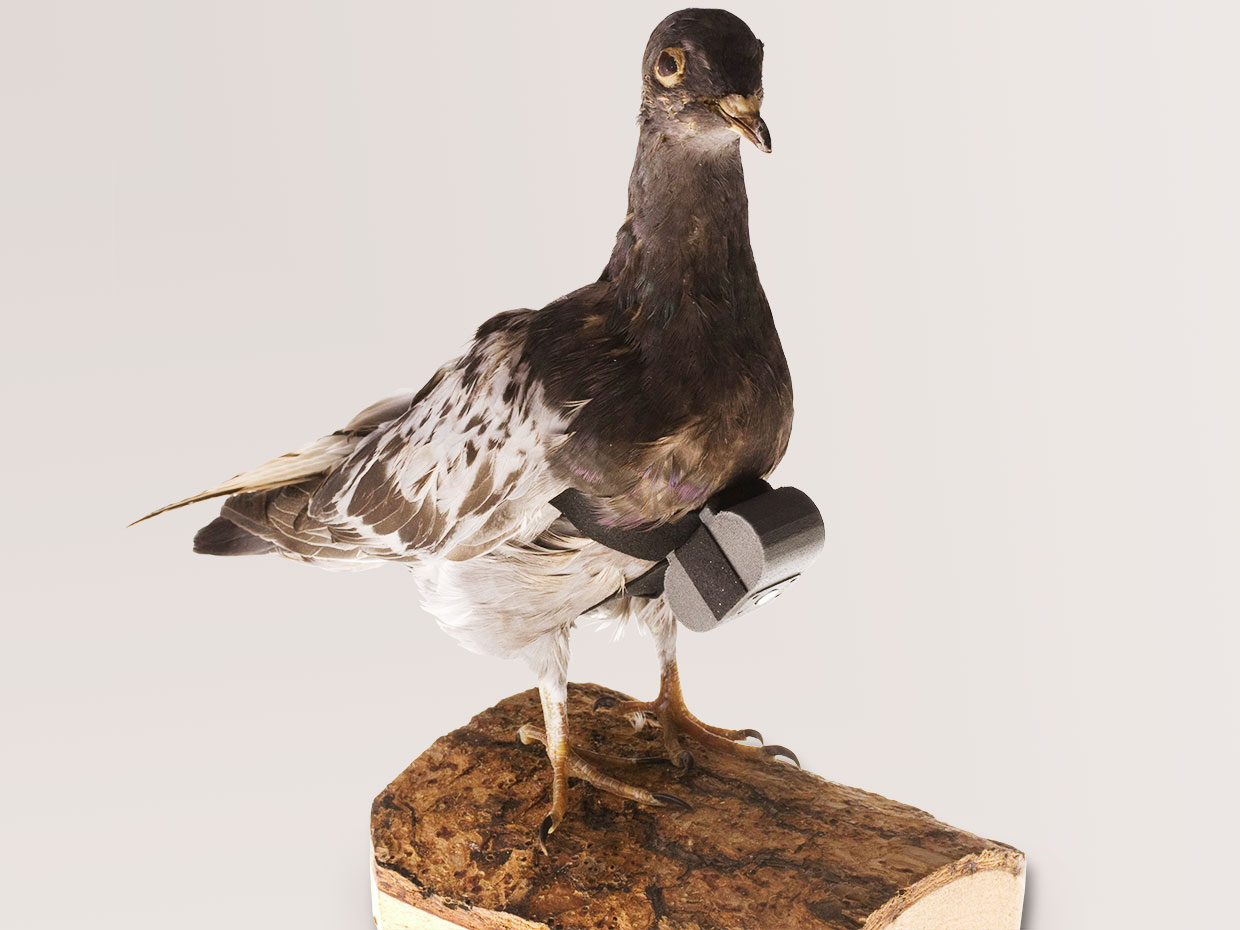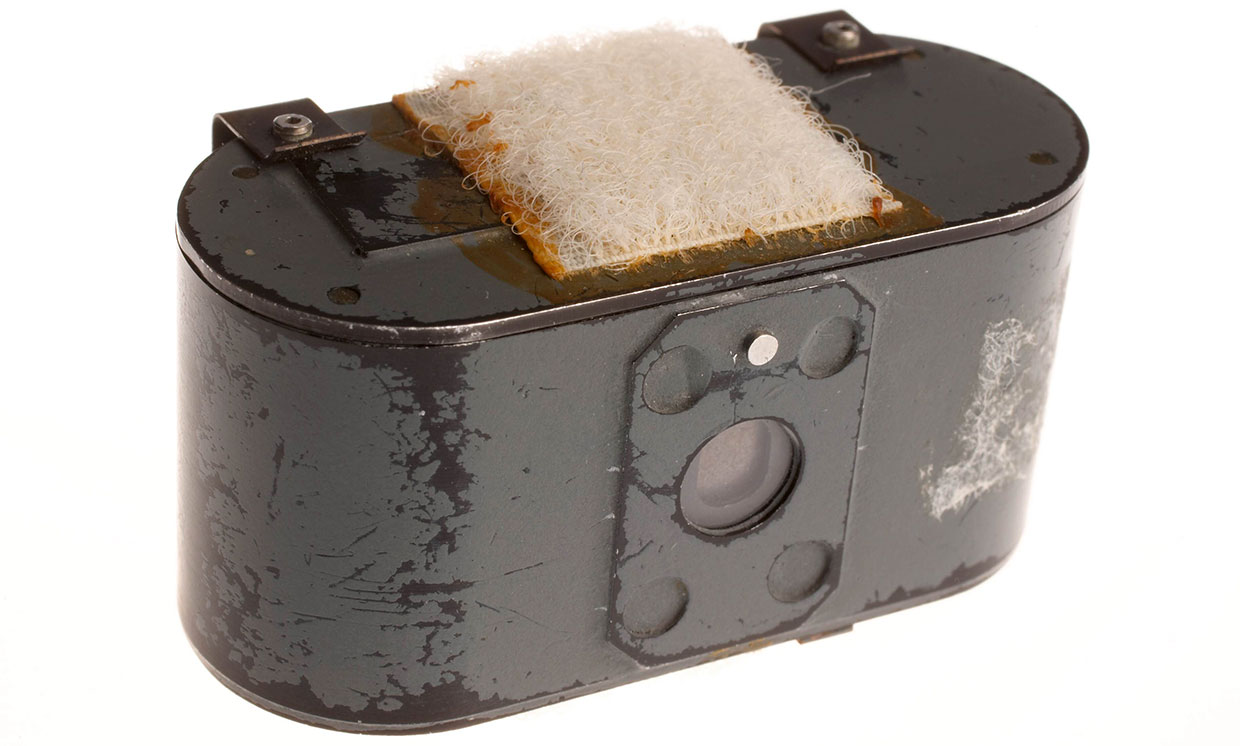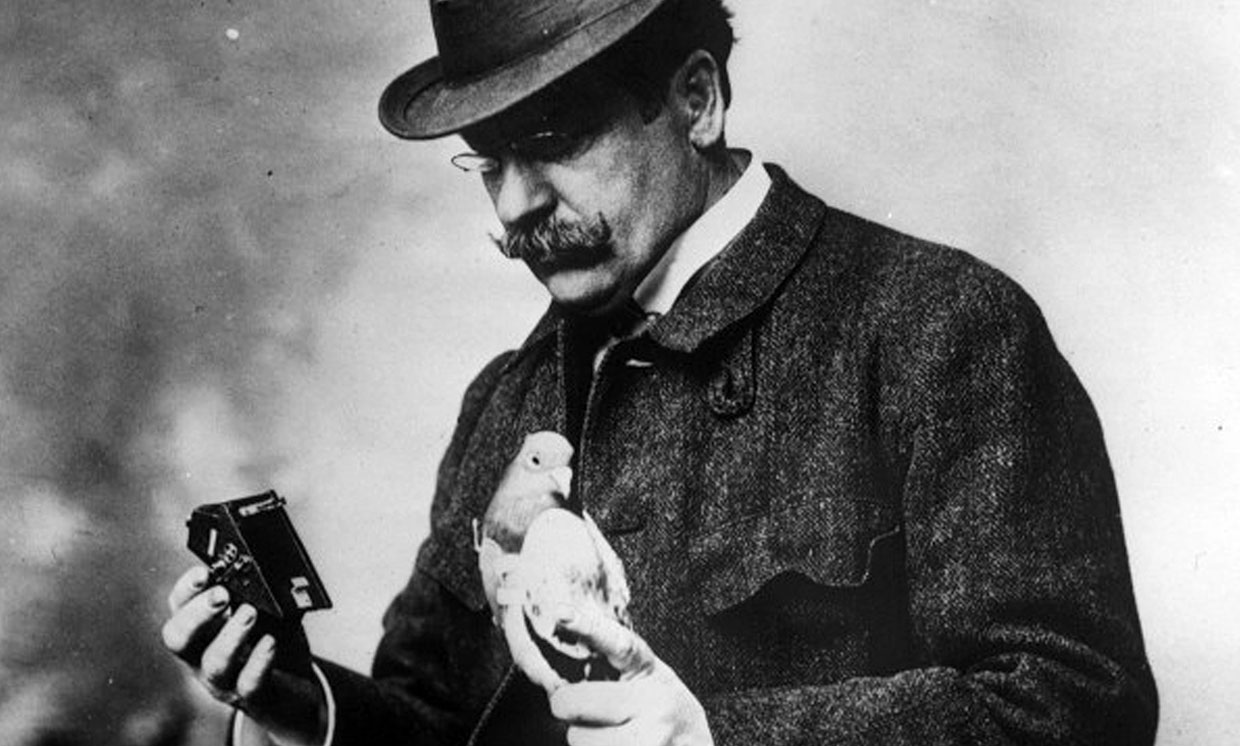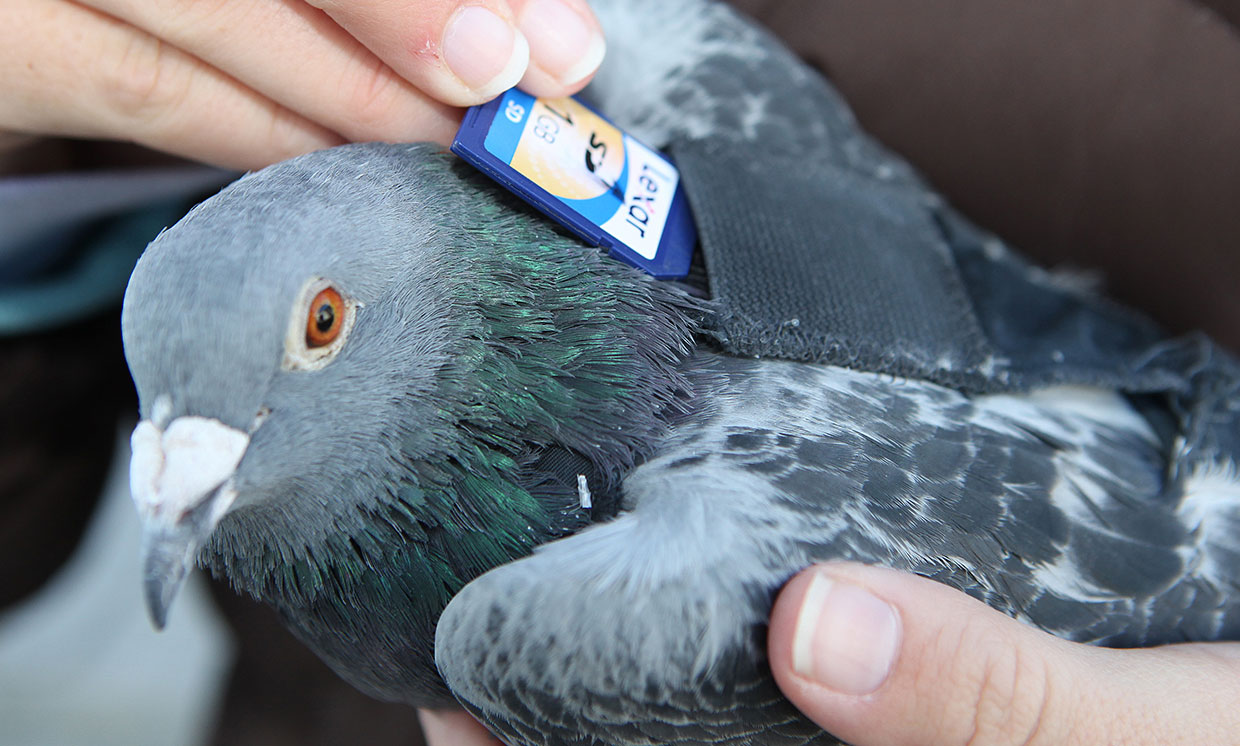Pay attention to carrier pigeons: the capabilities of this technology are amazing
- Transfer
About the Author: Allison Marsh is an associate professor of history at the University of South Carolina, one of the directors of the Anne Johnson Institute of Science, Technology and Society.

Avian espionage: in the 1970s, the CIA developed a tiny camera that turned pigeons into spies. For
thousands of years, pigeons carried messages. And they were especially useful in wartime. Julius Caesar, Genghis Khan, Arthur Wellesley Wellington (during the Battle of Waterloo ) - all of them relied on communication through birds. During the First World War, US liaison forces and the navy kept their dovecotes. The French government awarded the American bird nicknamed Cher Amy with the Military Cross for his valiant service during the Battle of Verdun. During World War II, the British held over 250,000 carrier pigeons, 32 of which received the Maria Dikin Medal, a special award for animals for military service [ from 1943 to 1949 the medal was awarded 54 times - thirty-two pigeons, eighteen dogs, three horses and a ship cat Simon / approx. perev. ].
And of course, the US Central Intelligence Agency could not help turning pigeons into spies. In the 1970s, the CIA's Research and Development Department created a small and lightweight camera that can be attached to a pigeon’s chest. After release, the dove flew over the goal of espionage on the way home. A battery-powered motor inside the camera scrolled through the film and opened the shutter. Since pigeons fly only a few hundred meters above the ground, they could receive much more detailed photographs compared to airplanes or satellites. Have there been testssuccessful pigeon photography ? We do not know. These data remain classified to this day.

However, the CIA was not the first to use this technology. German pharmacist Julius Gustav Neubronner is usually considered the first person to train pigeons for taking photographs from the air. At the beginning of the 20th century, Neubronner fastened cameras [of his own invention, using a pneumatic shutter opening / approx. perev. ] to the chest of carrier pigeons. The camera took pictures at regular intervals while the dove flew home.
The Prussian military studied the possibility of using Neubronner pigeons for reconnaissance, but abandoned the idea, being unable to control routes or take photos of certain places. Instead, Neubronner began making postcards from these shots. Now they are collected in the 2017 book " Pigeon Photographer ". Some of them can be viewed on the Internet:
The main reason that pigeons can be used for messaging or surveillance is their magnetoreception - the ability to sense the Earth's magnetic field, determining its location, direction of movement and orientation.
Early observations in Ancient Egypt and Mesopotamia showed that pigeons usually return home to their perch, even if released far away from home. But only relatively recently, scientists began to understand how magnetic orientation in birds works.
In 1968, the German zoologist Wolfgang Wilczko described a magnetic compass zaryanok, migratory birds. He watched as the caught zaryanki gathered from one edge of the cage, and looked in the direction in which they would move, being at large. When Vilchko manipulated the magnetic fields in the laboratory with Helmholtz rings , the zaryanki reacted to this by changing their orientation in space without visual or other clues.
It was more difficult to study magnetoreception of carrier pigeons, since birds have to be released into their natural environment in order for them to exhibit their characteristic behavior. Outside the laboratory, there is no easy way to control magnetic fields, so it was difficult to understand whether the birds rely on other methods of orientation, for example, the position of the Sun in the sky.
In the 1970s, Charles Walcot, an ornithologist from New York University at Stony Brook with his student Robert Green came up with a cunning experiment that allowed them to overcome such difficulties. First they trained a flock of 50 carrier pigeons to fly in sunny and cloudy conditions from west to east, releasing them from three different points.
After the pigeons began to return home stably, regardless of the weather, scientists dressed them in fashionable hats. They put coils with batteries on each pigeon - one coil surrounded the neck of the bird in the manner of a collar, and the other was glued to its head. Coils were used to change the magnetic field around the bird.
On sunny days, the presence of current in the coils had little effect on the birds. But in cloudy weather, the birds flew to the house or in the direction from it, depending on the direction of the magnetic field. This suggests that in clear weather the pigeons are guided by the sun, and on cloudy days they mainly use the Earth's magnetic field. Walcot and Green published their discoveries in Science in 1974.

At the beginning of the 20th century, Julius Gustav Neubronner used pigeons and cameras to take aerial photographs.
Additional research and experiments helped to clarify the theory of magnetoreception, but so far no one has been able to accurately indicate where the bird magnetoreceptors are located. In 2002, Vilchko and the team suggestedthat they are located in the right eye. But nine years later, another team of scientists published an answer to this work in the journal Nature, claiming that they were unable to reproduce the stated result.
The second theory was the beak - more precisely, the deposition of iron in the upper part of the beak in some birds. This idea was also rejected in 2012, when a team of scientists determined that the cells there are macrophages, part of the immune system. A few months later, David Dickman and Le-qing Wu suggested a third possibility: the inner ear. So far, the search for the causes of magnetoreception remains an area of active research.
Fortunately for those who want to create a dove, understanding where the birds know the direction of flight is not important. They just need to be trained to fly between two points. It is best to use a time-tested food stimulus. If you feed the pigeons in one place and keep in another, you can teach them to fly along this route. It is also possible to teach pigeons to return home from unfamiliar places. In competitions, birds can fly up to 1800 km , although a 1000 km distance is considered the usual range limit.
In the 19th century, pigeons carried messages packed in small tubes attached to their paws. Among typical routes there was a path from the island to the mainland city, from the village to the city center, and to other places where telegraph wires had not yet reached.
One pigeon could carry a limited number of regular messages - it does not have the carrying capacity of an Amazon drone. But the invention in the 1850s of microfilm, made by the French photographer Rene Dagron, allowed one bird to carry more words, and even images.
Ten years after the invention, when Paris was under siege during the Franco-Prussian War , Dagron proposed the use of pigeons for carrying micrographs of official and personal messages. Dagron's mail eventually sufferedmore than 150,000 microfilms, which in total contained more than a million messages. The Prussians appreciated what was happening, and took to the service of hawks and falcons, trying to intercept the winged messages.
In the 20th century, the reliability of regular communication via mail, telegraph and telephone grew, and pigeons gradually moved into the field of hobbies and special needs, becoming the subject of study for rare connoisseurs.
For example, in the mid-1990s, Rocky Mountain AdventuresRafting from Colorado included pigeon mail in her travels on the Cache la Powder River. The film taken along the way was loaded into small pigeon backpacks. Then the birds were released, and they returned to the headquarters of the company. By the time the rafters returned, the photographs were ready - pigeon mail made these souvenirs unique [ in the mountainous regions of Dagestan, some residents use pigeon mail , transmitting data on flash cards / approx. perev. ]

The company representative said that the birds have hard transferred the transition to digital technology. Transferring SD cards instead of films, they strove to fly into the forest, rather than return to the dovecote, possibly due to the fact that their load was much lighter. As a result, when all tourists gradually acquired smartphones, the company had to send pigeons to retire,
and my brief overview of messaging using pigeons would not be complete without mentioning the RFC from David Weizmann, sent to the Internet Engineering Council on April 1, 1990. RFC 1149 described the IPoAC protocol , Internet Protocol over Avian Carriers, that is, the transmission of Internet traffic through pigeons. In updateReleased on April 1, 1999, not only safety improvements were mentioned (“There are privacy issues regarding decoy pigeons” [ puns using the term stool pigeon, meaning both a stuffed bird designed to bait birds for hunting and a police officer informant / approx. transl. ]), but also questions of patenting (“Currently, there are legal proceedings regarding what appeared earlier - the carrier of information or the egg”).
In real-world tests of the IPoAC protocol in Australia, South Africa and Britain, birds competed with local telecommunications, the quality of which in some places left much to be desired. As a result, the birds won. For thousands of years serving as a means of messaging, doves do not give up to this day.
In the matter of establishing a connection between two points, nothing can defeat a pigeon. Except, perhaps, a rare hawk.

Avian espionage: in the 1970s, the CIA developed a tiny camera that turned pigeons into spies. For
thousands of years, pigeons carried messages. And they were especially useful in wartime. Julius Caesar, Genghis Khan, Arthur Wellesley Wellington (during the Battle of Waterloo ) - all of them relied on communication through birds. During the First World War, US liaison forces and the navy kept their dovecotes. The French government awarded the American bird nicknamed Cher Amy with the Military Cross for his valiant service during the Battle of Verdun. During World War II, the British held over 250,000 carrier pigeons, 32 of which received the Maria Dikin Medal, a special award for animals for military service [ from 1943 to 1949 the medal was awarded 54 times - thirty-two pigeons, eighteen dogs, three horses and a ship cat Simon / approx. perev. ].
And of course, the US Central Intelligence Agency could not help turning pigeons into spies. In the 1970s, the CIA's Research and Development Department created a small and lightweight camera that can be attached to a pigeon’s chest. After release, the dove flew over the goal of espionage on the way home. A battery-powered motor inside the camera scrolled through the film and opened the shutter. Since pigeons fly only a few hundred meters above the ground, they could receive much more detailed photographs compared to airplanes or satellites. Have there been testssuccessful pigeon photography ? We do not know. These data remain classified to this day.

However, the CIA was not the first to use this technology. German pharmacist Julius Gustav Neubronner is usually considered the first person to train pigeons for taking photographs from the air. At the beginning of the 20th century, Neubronner fastened cameras [of his own invention, using a pneumatic shutter opening / approx. perev. ] to the chest of carrier pigeons. The camera took pictures at regular intervals while the dove flew home.
The Prussian military studied the possibility of using Neubronner pigeons for reconnaissance, but abandoned the idea, being unable to control routes or take photos of certain places. Instead, Neubronner began making postcards from these shots. Now they are collected in the 2017 book " Pigeon Photographer ". Some of them can be viewed on the Internet:
The main reason that pigeons can be used for messaging or surveillance is their magnetoreception - the ability to sense the Earth's magnetic field, determining its location, direction of movement and orientation.
Early observations in Ancient Egypt and Mesopotamia showed that pigeons usually return home to their perch, even if released far away from home. But only relatively recently, scientists began to understand how magnetic orientation in birds works.
In 1968, the German zoologist Wolfgang Wilczko described a magnetic compass zaryanok, migratory birds. He watched as the caught zaryanki gathered from one edge of the cage, and looked in the direction in which they would move, being at large. When Vilchko manipulated the magnetic fields in the laboratory with Helmholtz rings , the zaryanki reacted to this by changing their orientation in space without visual or other clues.
It was more difficult to study magnetoreception of carrier pigeons, since birds have to be released into their natural environment in order for them to exhibit their characteristic behavior. Outside the laboratory, there is no easy way to control magnetic fields, so it was difficult to understand whether the birds rely on other methods of orientation, for example, the position of the Sun in the sky.
In the 1970s, Charles Walcot, an ornithologist from New York University at Stony Brook with his student Robert Green came up with a cunning experiment that allowed them to overcome such difficulties. First they trained a flock of 50 carrier pigeons to fly in sunny and cloudy conditions from west to east, releasing them from three different points.
After the pigeons began to return home stably, regardless of the weather, scientists dressed them in fashionable hats. They put coils with batteries on each pigeon - one coil surrounded the neck of the bird in the manner of a collar, and the other was glued to its head. Coils were used to change the magnetic field around the bird.
On sunny days, the presence of current in the coils had little effect on the birds. But in cloudy weather, the birds flew to the house or in the direction from it, depending on the direction of the magnetic field. This suggests that in clear weather the pigeons are guided by the sun, and on cloudy days they mainly use the Earth's magnetic field. Walcot and Green published their discoveries in Science in 1974.

At the beginning of the 20th century, Julius Gustav Neubronner used pigeons and cameras to take aerial photographs.
Additional research and experiments helped to clarify the theory of magnetoreception, but so far no one has been able to accurately indicate where the bird magnetoreceptors are located. In 2002, Vilchko and the team suggestedthat they are located in the right eye. But nine years later, another team of scientists published an answer to this work in the journal Nature, claiming that they were unable to reproduce the stated result.
The second theory was the beak - more precisely, the deposition of iron in the upper part of the beak in some birds. This idea was also rejected in 2012, when a team of scientists determined that the cells there are macrophages, part of the immune system. A few months later, David Dickman and Le-qing Wu suggested a third possibility: the inner ear. So far, the search for the causes of magnetoreception remains an area of active research.
Fortunately for those who want to create a dove, understanding where the birds know the direction of flight is not important. They just need to be trained to fly between two points. It is best to use a time-tested food stimulus. If you feed the pigeons in one place and keep in another, you can teach them to fly along this route. It is also possible to teach pigeons to return home from unfamiliar places. In competitions, birds can fly up to 1800 km , although a 1000 km distance is considered the usual range limit.
In the 19th century, pigeons carried messages packed in small tubes attached to their paws. Among typical routes there was a path from the island to the mainland city, from the village to the city center, and to other places where telegraph wires had not yet reached.
One pigeon could carry a limited number of regular messages - it does not have the carrying capacity of an Amazon drone. But the invention in the 1850s of microfilm, made by the French photographer Rene Dagron, allowed one bird to carry more words, and even images.
Ten years after the invention, when Paris was under siege during the Franco-Prussian War , Dagron proposed the use of pigeons for carrying micrographs of official and personal messages. Dagron's mail eventually sufferedmore than 150,000 microfilms, which in total contained more than a million messages. The Prussians appreciated what was happening, and took to the service of hawks and falcons, trying to intercept the winged messages.
In the 20th century, the reliability of regular communication via mail, telegraph and telephone grew, and pigeons gradually moved into the field of hobbies and special needs, becoming the subject of study for rare connoisseurs.
For example, in the mid-1990s, Rocky Mountain AdventuresRafting from Colorado included pigeon mail in her travels on the Cache la Powder River. The film taken along the way was loaded into small pigeon backpacks. Then the birds were released, and they returned to the headquarters of the company. By the time the rafters returned, the photographs were ready - pigeon mail made these souvenirs unique [ in the mountainous regions of Dagestan, some residents use pigeon mail , transmitting data on flash cards / approx. perev. ]

The company representative said that the birds have hard transferred the transition to digital technology. Transferring SD cards instead of films, they strove to fly into the forest, rather than return to the dovecote, possibly due to the fact that their load was much lighter. As a result, when all tourists gradually acquired smartphones, the company had to send pigeons to retire,
and my brief overview of messaging using pigeons would not be complete without mentioning the RFC from David Weizmann, sent to the Internet Engineering Council on April 1, 1990. RFC 1149 described the IPoAC protocol , Internet Protocol over Avian Carriers, that is, the transmission of Internet traffic through pigeons. In updateReleased on April 1, 1999, not only safety improvements were mentioned (“There are privacy issues regarding decoy pigeons” [ puns using the term stool pigeon, meaning both a stuffed bird designed to bait birds for hunting and a police officer informant / approx. transl. ]), but also questions of patenting (“Currently, there are legal proceedings regarding what appeared earlier - the carrier of information or the egg”).
In real-world tests of the IPoAC protocol in Australia, South Africa and Britain, birds competed with local telecommunications, the quality of which in some places left much to be desired. As a result, the birds won. For thousands of years serving as a means of messaging, doves do not give up to this day.
